Evaluating the Spatiotemporal Distributions of Water Conservation in the Yiluo River Basin under a Changing Environment
Abstract
1. Introduction
2. Materials and Methods
2.1. Study Area
2.2. Data Source and Processing Method
2.3. Methodology
2.3.1. Statistic Method for Analyzing Abrupt Changes in Hydrological and Meteorological Conditions
2.3.2. Development of the SWAT Model and Assessment of Water Conservation
2.3.3. SUFI-2 Uncertainty Analysis Algorithm
2.3.4. Temporal Correlation Analysis and Geodetector Tool
2.3.5. Water Conservation Importance Classification
3. Results
3.1. Meteorological, Hydrological and Land Use Changes
3.2. Model Analysis and Evaluation
3.2.1. Model Calibration and Validation
3.2.2. Uncertainty Analysis
3.3. Spatial and Temporal Distribution of Water Conservation
3.3.1. Temporal Distribution of Water Conservation
3.3.2. Spatial Distribution of Water Conservation
3.4. Spatial Division of Water Conservation Importance
3.5. Key Factors That Affect Water Conservation
3.5.1. Temporal Correlation Analysis
3.5.2. Spatial Correlation Analysis
4. Discussion
4.1. Environmental Protection Strategies
4.2. Improvement in Research Ideas and Methods
4.3. Implications and Limitations
5. Conclusions
- (1)
- The average water conservation depths calculated by the SWAT model are 157 mm from 1966 to 1985, 100 mm from 1986 to 2000, and 83 mm from 2001 to 2018. The multiyear average depth of water conservation is approximately 116 mm. Water conservation declined significantly over the past several decades due to changes in climatic conditions and subsurface characteristics.
- (2)
- The study proposes environmental protection strategies based on water conservation importance and Sen–MK trends. The water conservation depth of extremely important areas, such as Luonan County, Luanchuan County, and Luoning County, decreased significantly over the past decades. Key strategies include protecting forests and vegetation in these highly important areas, implementing vegetation restoration and soil conservation projects in areas at risk, and promoting rational land use planning to maintain water conservation in urban areas.
- (3)
- The comprehensive analysis initially identified precipitation, maximum temperature, and potential evapotranspiration as the primary factors influencing water conservation, based on temporal correlation analysis. Subsequent spatial correlation analysis, employing Geodetector, highlighted potential evapotranspiration, elevation, and vegetation as exhibiting the strongest spatial correlations with water conservation.
Author Contributions
Funding
Data Availability Statement
Acknowledgments
Conflicts of Interest
References
- Tian, Q.; Yang, S.L. Regional climatic response to global warming: Trends in temperature and precipitation in the Yellow, Yangtze and Pearl River basins since the 1950s. Quat. Int. 2017, 440, 1–11. [Google Scholar] [CrossRef]
- Wang, G.Q. Definition of the Yellow River Basin Water Conservation Zone. J. China Hydrol. 2022, 42, 65, (In Chinese with an English Abstract). [Google Scholar]
- Zuo, Q.T. Research framework for ecological protection and high-quality development in the Yellow River Basin. Yellow River 2019, 41, 1–6+16, (In Chinese with an English Abstract). [Google Scholar]
- Hu, W.M.; Li, G.; Gao, Z.H.; Jia, G.Y.; Wang, Z.C.; Li, Y. Assessment of the impact of the Poplar Ecological Retreat Project on water conservation in the Dongting Lake wetland region using the InVEST model. Sci. Total Environ. 2020, 733, 139423. [Google Scholar] [CrossRef] [PubMed]
- Zhou, J.W.; Gao, J.X.; Gao, Z.Q.; Yang, W.C. Analyzing the water conservation service function of the forest ecosystem. Acta Ecol. Sin. 2018, 38, 1679–1686, (In Chinese with an English Abstract). [Google Scholar]
- Nie, Y.H. A study of the water conservation of Qilian Mountains based on surface energy balance and SCS model. Earth Sci. Front. 2010, 17, 269–275, (In Chinese with an English Abstract). [Google Scholar]
- Zhang, Y.W.; Zhang, B.; Ma, B.; Yao, R.P.; Wang, L.B. Evaluation of the water conservation capacity of the Weihe River Basin based on the Integrated Valuation of Ecosystem Services and Tradeoffs model. Ecohydrology 2022, 15, e2465. [Google Scholar] [CrossRef]
- Lin, F.; Chen, X.W.; Yao, W.Y.; Fang, Y.H.; Deng, H.J.; Wu, J.F.; Lin, B.Q. Multi-time scale analysis of water conservation in a discontinuous forest watershed based on SWAT model. Acta Geogr. Sin. 2020, 75, 1065–1078, (In Chinese with an English Abstract). [Google Scholar] [CrossRef]
- Arnold, J.G.; Srinivasan, R.; Muttiah, R.S.; Williams, J.R. Large area hydrologic modeling and assessment—Part 1: Model development. J. Am. Water Resour. Assoc. 1998, 34, 73–89. [Google Scholar] [CrossRef]
- Douglas-Mankin, K.R.; Srinivasan, R.; Arnold, J.G. Soil and Water Assessment Tool (SWAT) Model: Current Developments and Applications. Trans. ASABE 2010, 53, 1423–1431. [Google Scholar] [CrossRef]
- Liu, J.F.; Jiang, W.G.; Zhan, W.F.; Zhou, J. Processes of SCS Model for Hydrological Simulation: A Review. Res. Soil Water Conserv. 2010, 17, 120–124, (In Chinese with an English Abstract). [Google Scholar]
- Chen, S.L. Estimating Forest Ecosystem Service Function of Water Conservation Based on TVDI. Ecol. Econ. 2016, 32, 5, (In Chinese with an English Abstract). [Google Scholar]
- Li, M.; Liang, D.; Xia, J.; Song, J.; Cheng, D.; Wu, J.; Cao, Y.; Sun, H.; Li, Q. Evaluation of water conservation function of Danjiang River Basin in Qinling Mountains, China based on InVEST model. J. Environ. Manag. 2021, 286, 112212, (In Chinese with an English Abstract). [Google Scholar] [CrossRef] [PubMed]
- Tang, Y.H.; Sun, Y.; Han, Z.Y.; Soomro, S.-e.-h.; Wu, Q.; Tan, B.Y.; Hu, C.H. flood forecasting based on machine learning pattern recognition and dynamic migration of parameters. J. Hydrol. Reg. Stud. 2023, 47, 101406. [Google Scholar] [CrossRef]
- Hu, C.H.; Zhang, L.; Wu, Q.; Soomro, S.-e.-h.; Jian, S.Q. Response of LUCC on Runoff Generation Process in Middle Yellow River Basin: The Gushanchuan Basin. Water 2020, 12, 1237. [Google Scholar] [CrossRef]
- Soomro, S.-e.-h.; Hu, C.; Boota, M.W.; Ahmed, Z.; Chengshuai, L.; Zhenyue, H.; Xiang, L.; Soomro, M.H.A.A. River Flood Susceptibility and Basin Maturity Analyzed Using a Coupled Approach of Geo-morphometric Parameters and SWAT Model. Water Resour. Manag. 2022, 36, 2131–2160. [Google Scholar] [CrossRef]
- Chung, I.-M.; Lee, J.; Kim, N.W.; Na, H.; Chang, S.W.; Kim, Y.; Kim, G.-B. Estimating exploitable amount of groundwater abstraction using an integrated surface water-groundwater model: Mihocheon watershed, South Korea. Hydrol. Sci. J. 2014, 60, 863–872. [Google Scholar] [CrossRef]
- Goldstein, J.C.; Tarhule, A. Evaluating the impacts of climate change and switchgrass production on a semiarid basin. Hydrol. Process. 2014, 29, 724–738. [Google Scholar] [CrossRef]
- Zhai, J.; Hou, P.; Zhang, W.G.; Chen, Y.; Jin, D.D.; Gao, H.F.; Zhu, H.S.; Yang, M. Assessment of Water Conservation Services Based on the Method of Integrating Hydrological Observation Data According to Different Ecosystem Types and Regions. Water 2023, 15, 1475. [Google Scholar] [CrossRef]
- Hou, J.; Qin, T.L.; Liu, S.S.; Wang, J.W.; Dong, B.Q.; Yan, S.; Nie, H.J. Analysis and Prediction of Ecosystem Service Values Based on Land Use/Cover Change in the Yiluo River Basin. Sustainability 2021, 13, 6432. [Google Scholar] [CrossRef]
- Wang, S.; Zhang, B.; Wang, S.; Xie, G.D. Dynamic changes in water conservation in the Beijing–Tianjin Sandstorm Source Control Project Area: A case study of Xilin Gol League in China. J. Clean. Prod. 2021, 293, 126054. [Google Scholar] [CrossRef]
- Guo, Y.L.; Lu, X.L.; Ding, S.Y. The classification of plant functional types based on the dominant herbaceous species in the riparian zone ecosystems in the Yiluo River. Acta Ecol. Sin. 2012, 32, 4434–4442, (In Chinese with an English Abstract). [Google Scholar]
- Wang, T.; Zhou, D.W.; Shen, X.J.; Fan, G.H.; Zhang, H. Koppen’s climate classification map for China. J. Meteorol. Sci. 2020, 40, 752–760, (In Chinese with an English Abstract). [Google Scholar]
- Wu, J.; Gao, X.J.; Giorgi, F.; Chen, D.L. Changes of effective temperature and cold/hot days in late decades over China based on a high resolution gridded observation dataset. Int. J. Climatol. 2017, 37, 788–800. [Google Scholar] [CrossRef]
- Wu, J.; Gao, X. A gridded daily observation dataset over China region and comparison with the other dataset. Chin. J. Geophys 2013, 56, 1102–1111, (In Chinese with an English Abstract). [Google Scholar]
- Xu, Y.; Gao, X.J.; Shen, Y.; Xu, C.H.; Shi, Y.; Giorgi, F. A daily temperature dataset over China and its application in validating a RCM simulation. Adv. Atmos. Sci. 2009, 26, 763–772. [Google Scholar] [CrossRef]
- Hamed, K.H.; Rao, A.R. A modified Mann-Kendall trend test for autocorrelated data. J. Hydrol. 1998, 204, 182–196. [Google Scholar] [CrossRef]
- Khaliq, M.N.; Ouarda, T.; Gachon, P.; Sushama, L.; St-Hilaire, A. Identification of hydrological trends in the presence of serial and cross correlations: A review of selected methods and their application to annual flow regimes of Canadian rivers. J. Hydrol. 2009, 368, 117–130. [Google Scholar] [CrossRef]
- Arnold, J.G.; Moriasi, D.N.; Gassman, P.W.; Abbaspour, K.C.; White, M.J.; Srinivasan, R.; Santhi, C.; Harmel, D.; Griensven, A.V.; Van Liew, M.W.; et al. SWAT: Model Use, Calibration, and Validation. Trans. ASABE 2012, 55, 1491–1508. [Google Scholar] [CrossRef]
- Zhang, X.S.; Srinivasan, R.; Debele, B.; Hao, F.H. Runoff Simulation of the Headwaters of the Yellow River Using The SWAT Model with Three Snowmelt Algorithms1. JAWRA J. Am. Water Resour. Assoc. 2008, 44, 48–61. [Google Scholar] [CrossRef]
- Yang, J.; Reichert, P.; Abbaspour, K.C.; Xia, J.; Yang, H. Comparing uncertainty analysis techniques for a SWAT application to the Chaohe Basin in China. J. Hydrol. 2008, 358, 1–23. [Google Scholar] [CrossRef]
- Pearson, K. Mathematical Contributions to the Theory of Evolution. III. Regression, Heredity, and Panmixia. Philos. Trans. R. Soc. A 1986, 187, 253–318. [Google Scholar]
- Wang, J.F.; Xu, C.d. Geodetector: Principle and prospective. Acta Geogr. Sin. 2017, 72, 116–134, (In Chinese with an English Abstract). [Google Scholar] [CrossRef]
- Wang, J.F.; Li, X.H.; Christakos, G.; Liao, Y.L.; Zhang, T.; Gu, X.; Zheng, X.Y. Geographical Detectors-Based Health Risk Assessment and its Application in the Neural Tube Defects Study of the Heshun Region, China. Int. J. Geogr. Inf. Sci. 2010, 24, 107–127, (In Chinese with an English Abstract). [Google Scholar] [CrossRef]
- Bai, S.; Jing, L.; Li, H.; Feng, W. The Demaracation of ecological protection red line based on water conservation function. Ecol. Environ. Sci. 2017, 26, 1665–1670, (In Chinese with an English Abstract). [Google Scholar] [CrossRef]
- Cai, B.F.; Yu, R. Advance and evaluation in the long time series vegetation trends research based on remote sensing. Natl. Remote Sens. Bull. 2009, 13, 1170–1186, (In Chinese with an English Abstract). [Google Scholar]
- De Beurs, K.M.; Henebry, G.M. A statistical framework for the analysis of long image time series. Int. J. Remote Sens. 2005, 26, 1551–1573. [Google Scholar] [CrossRef]
- Mann, H.B. Nonparametric Tests Against Trend. Econometrica 1945, 13, 245. [Google Scholar] [CrossRef]
- Kendall, M.G. Rank Correlation Methods; Griffin: Oxford, England, 1948. [Google Scholar]
- Lambin, E.F.; Turner, B.L.; Geist, H.J.; Agbola, S.B.; Angelsen, A.; Bruce, J.W.; Coomes, O.T.; Dirzo, R.; Fischer, G.; Folke, C.; et al. The causes of land-use and land-cover change: Moving beyond the myths. Glob. Environ. Chang. Hum. Policy Dimens. 2001, 11, 261–269. [Google Scholar] [CrossRef]
- Turner, B.L.; Lambin, E.F.; Reenberg, A. Land Change Science Special Feature: The emergence of land change science for global environmental change and sustainability. Proc. Natl. Acad. Sci. USA 2007, 104, 20666–20671, Erratum in Proc. Natl. Acad. Sci. USA 2008, 105, 2751. [Google Scholar] [CrossRef]
- Zhang, P.; Shao, G.; Zhao, G.; Le Master, D.C.; Parker, G.R.; Dunning, J.B., Jr.; Li, Q. China’s forest policy for the 21st century. Science 2000, 288, 2135–2136. [Google Scholar] [CrossRef] [PubMed]
- Huang, B.B.; Hao, C.Y.; Li, R.N.; Zheng, H. Research Progress on the Quantitative Methods of Calculating Contribution Rates of Climate Change and Human Activities to Surface Runoff Changes. J. Nat. Resour. 2018, 33, 899–910, (In Chinese with an English Abstract). [Google Scholar]
- Wang, Z.Z.; Fu, B.J.; Wu, X.T.; Li, Y.J.; Wang, S.; Lu, N. Escaping social–ecological traps through ecological restoration and socioeconomic development in China’s Loess Plateau. People Nat. 2023, 5, 1364–1379. [Google Scholar] [CrossRef]
- Yin, S.H.; Gao, G.Y.; Ran, L.H.; Li, D.F.; Lu, X.X.; Fu, B.J. Extreme streamflow and sediment load changes in the Yellow River Basin: Impacts of climate change and human activities. J. Hydrol. 2023, 619, 129372. [Google Scholar] [CrossRef]
- Wang, D.D.; Jia, Y.W.; Niu, C.W.; Sui, Y.B.; Yang, X. Evaluation method for main functions of water retention based on WEP-L model: A case of water retention area in Wei River. Acta Ecol. Sin. 2024, 44, 4342–4352, (In Chinese with an English Abstract). [Google Scholar]
- Shao, D.; Chen, S.; Tan, X.; Gu, W. Drought characteristics over China during 1980–2015. Int. J. Climatol. 2018, 38, 3532–3545. [Google Scholar] [CrossRef]
- Yao, N.; Li, Y.; Lei, T.; Peng, L. Drought evolution, severity and trends in mainland China over 1961-2013. Sci. Total Environ. 2018, 616–617, 73–89. [Google Scholar] [CrossRef]
- Sui, Y.B.; Niu, C.W.; Jia, Y.W.; Yang, X.; Wang, D.D. Precipitation, temperature and runoff for the recent 60 years in the Yellow River water conservation area of China and their influence on water conservation. Mt. Res. 2023, 41, 41–55, (In Chinese with an English Abstract). [Google Scholar]
- Berghuijs, W.R.; Larsen, J.R.; van Emmerik, T.H.M.; Woods, R.A. A Global Assessment of Runoff Sensitivity to Changes in Precipitation, Potential Evaporation, and Other Factors. Water Resour. Res. 2017, 53, 8475–8486. [Google Scholar] [CrossRef]
- Wang, X.X.; Shen, H.T.; Li, X.Y.; Jing, F. Concepts, processes and quantification methods of the forest water conservation at the multiple scales. Acta Ecol. Sin. 2013, 33, 1019–1030, (In Chinese with an English Abstract). [Google Scholar] [CrossRef]
- Cong, W.C.; Sun, X.Y.; Guo, H.W.; Shan, R.F. Comparison of the SWAT and InVEST models to determine hydrological ecosystem service spatial patterns, priorities and trade-offs in a complex basin. Ecol. Indic. 2020, 112, 106089. [Google Scholar] [CrossRef]
- Lüke, A.; Hack, J. Comparing the Applicability of Commonly Used Hydrological Ecosystem Services Models for Integrated Decision-Support. Sustainability 2018, 10, 346. [Google Scholar] [CrossRef]
- Ju, Q.; Shen, T.; Zhao, W.; Wang, X.; Jiang, P.; Wang, G.; Liu, Y.; Wang, Q.; Yu, Z. Simulation and prediction of changes in maximum freeze depth in the source region of the Yellow River under climate change. Sci. Total Environ. 2023, 905, 167136. [Google Scholar] [CrossRef] [PubMed]
- Wu, J.Y.; Ju, Q.; Liu, X.N.; Lian, Z.X.; Zhang, Y.Y.; Duan, Y.Y. Assessment of precipitation and temperature in the water conservation region of the Yellow River Basin using CMIP6 models. Hydro-Sci. Eng. 2023, 1–14, (In Chinese with an English Abstract). [Google Scholar]
- Jia, Y.F.; Wang, G.Q. Assessment of water conservation capavity of Yiluo River Basin based on the InVEST Model. J. Soil Water Conserv. 2023, 37, 101–108, (In Chinese with an English Abstract). [Google Scholar]
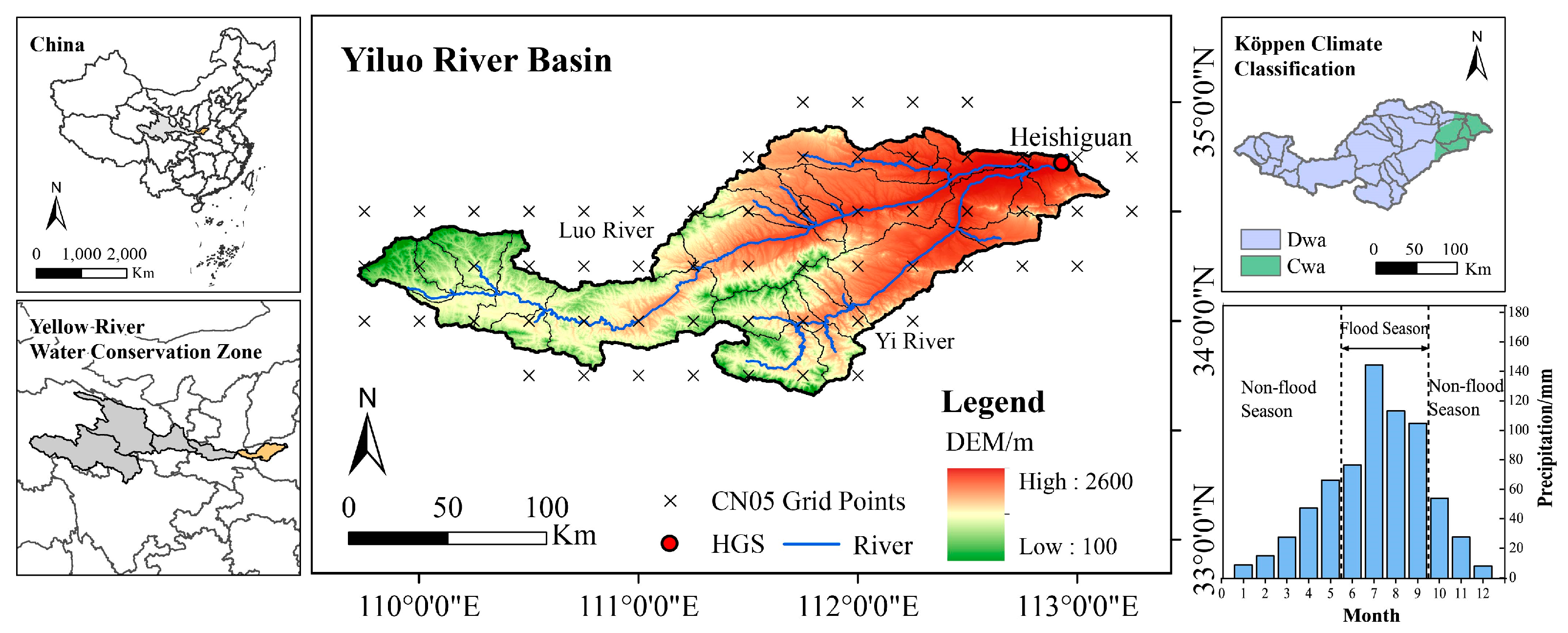


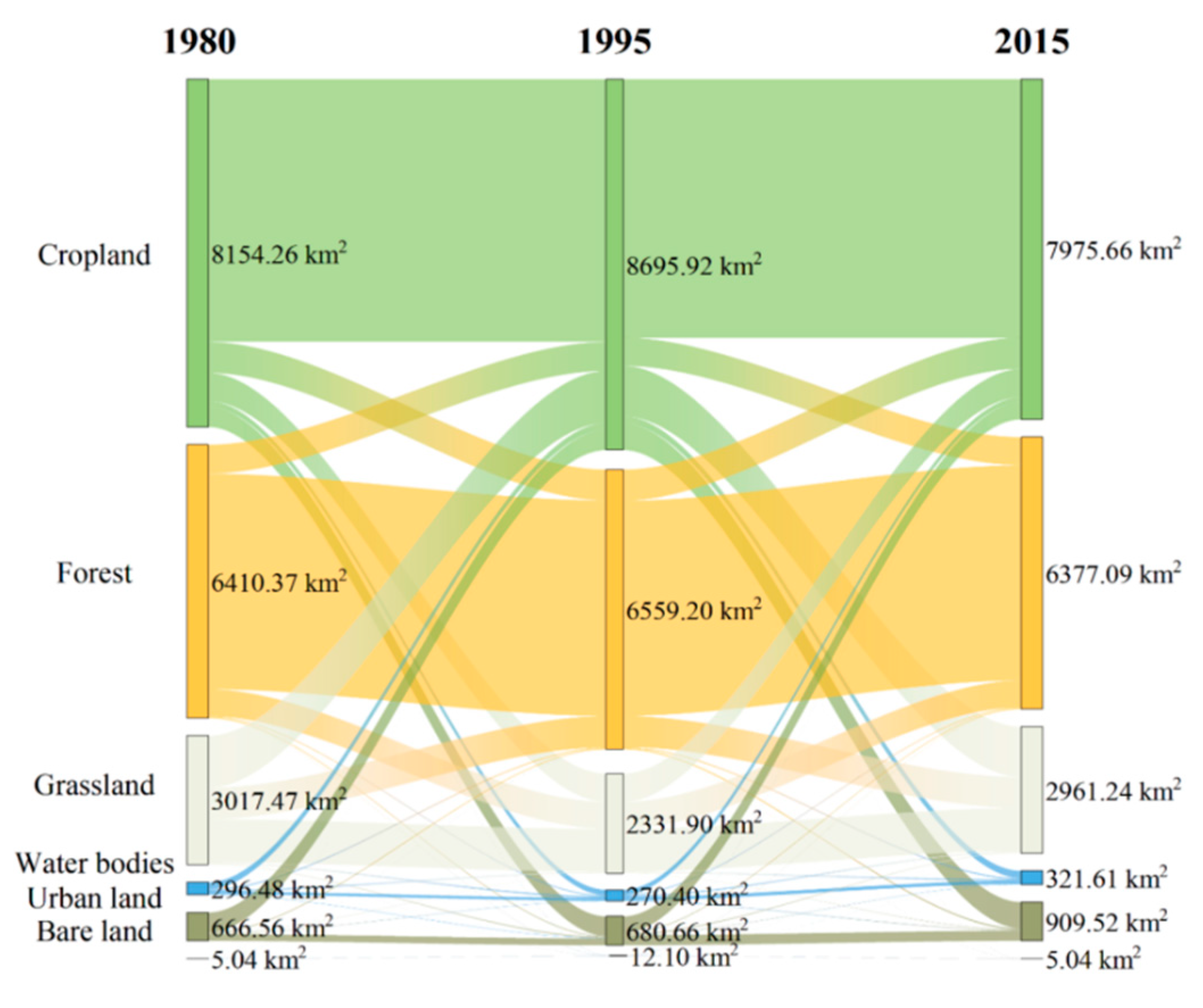


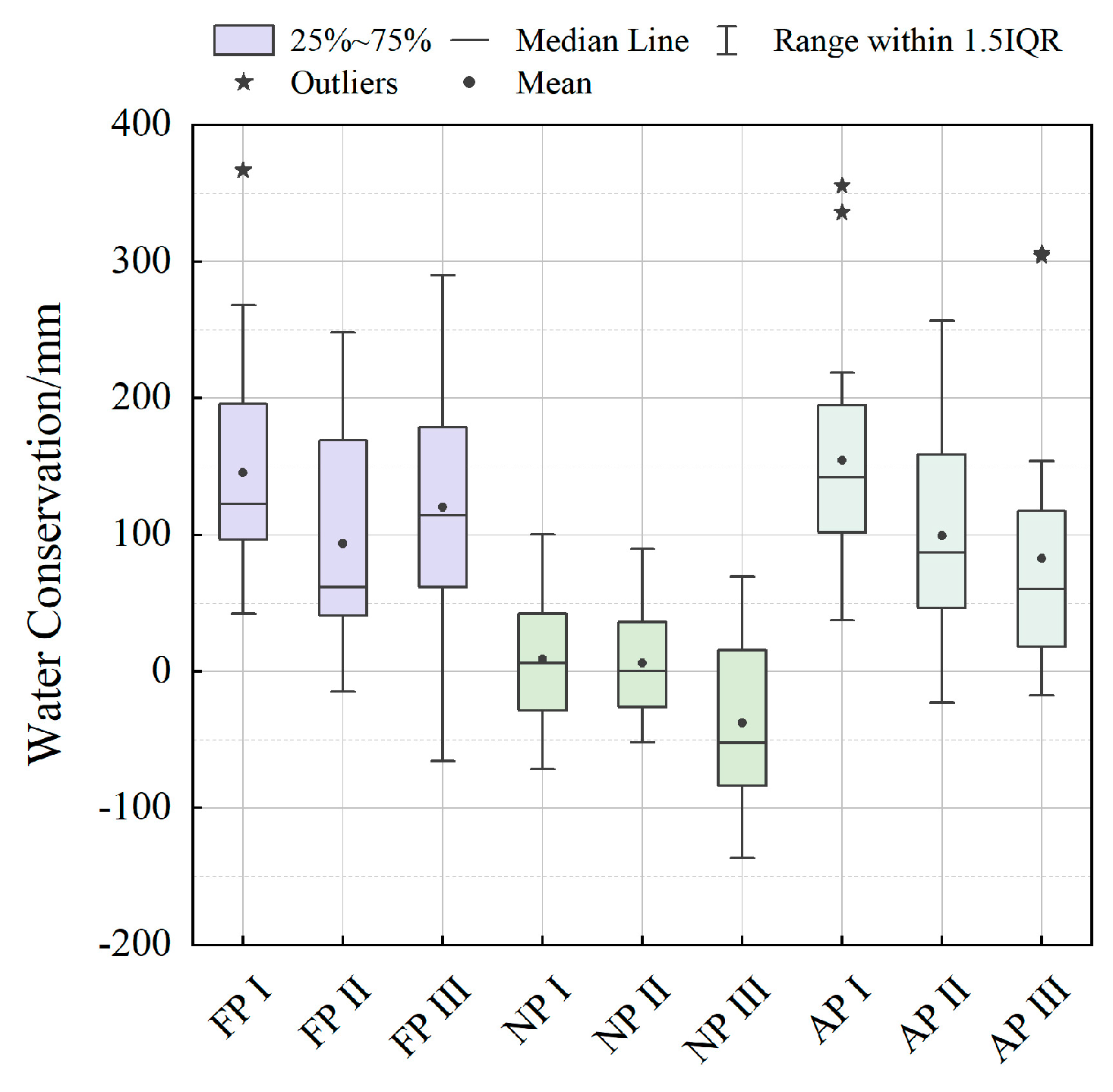
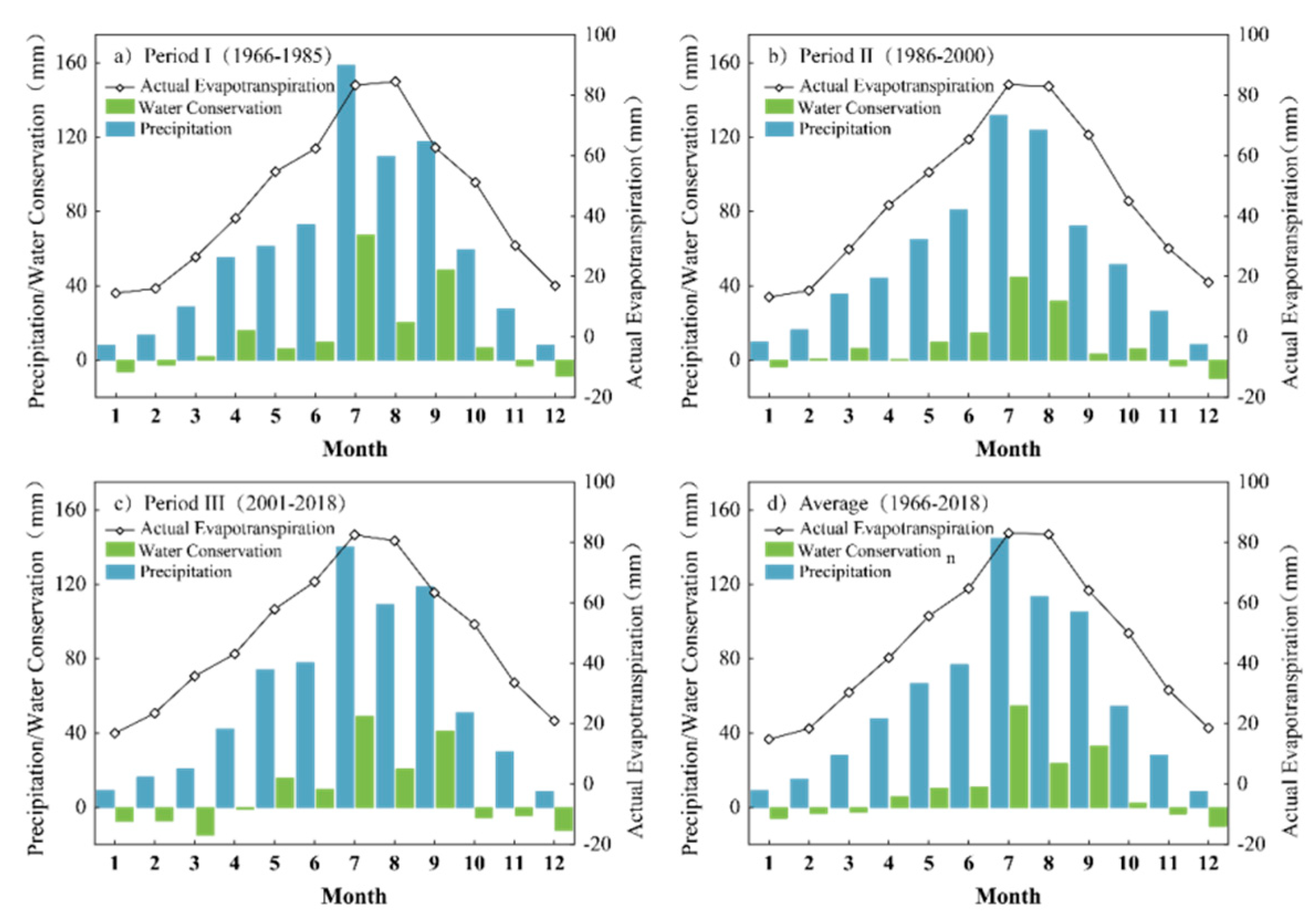
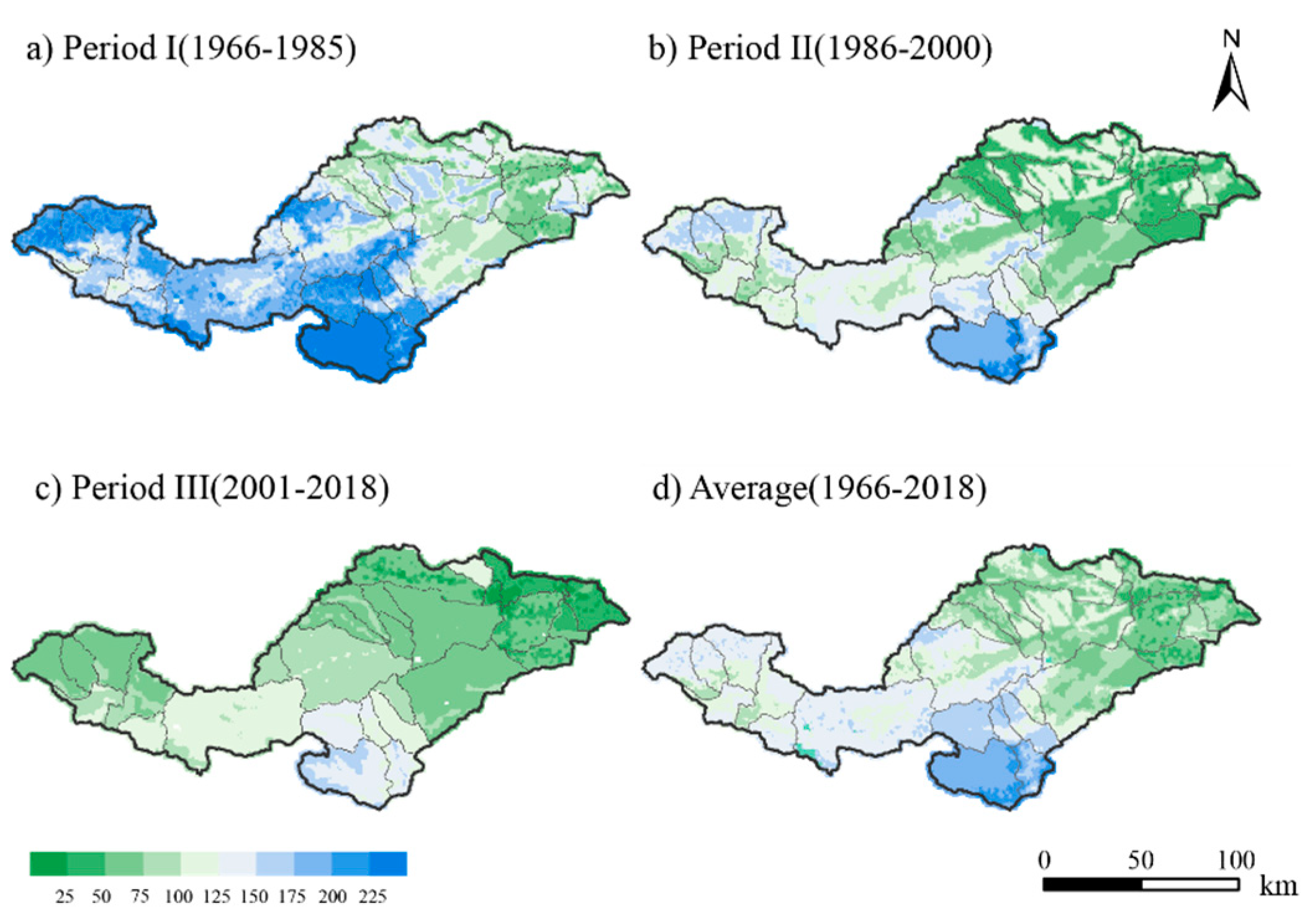

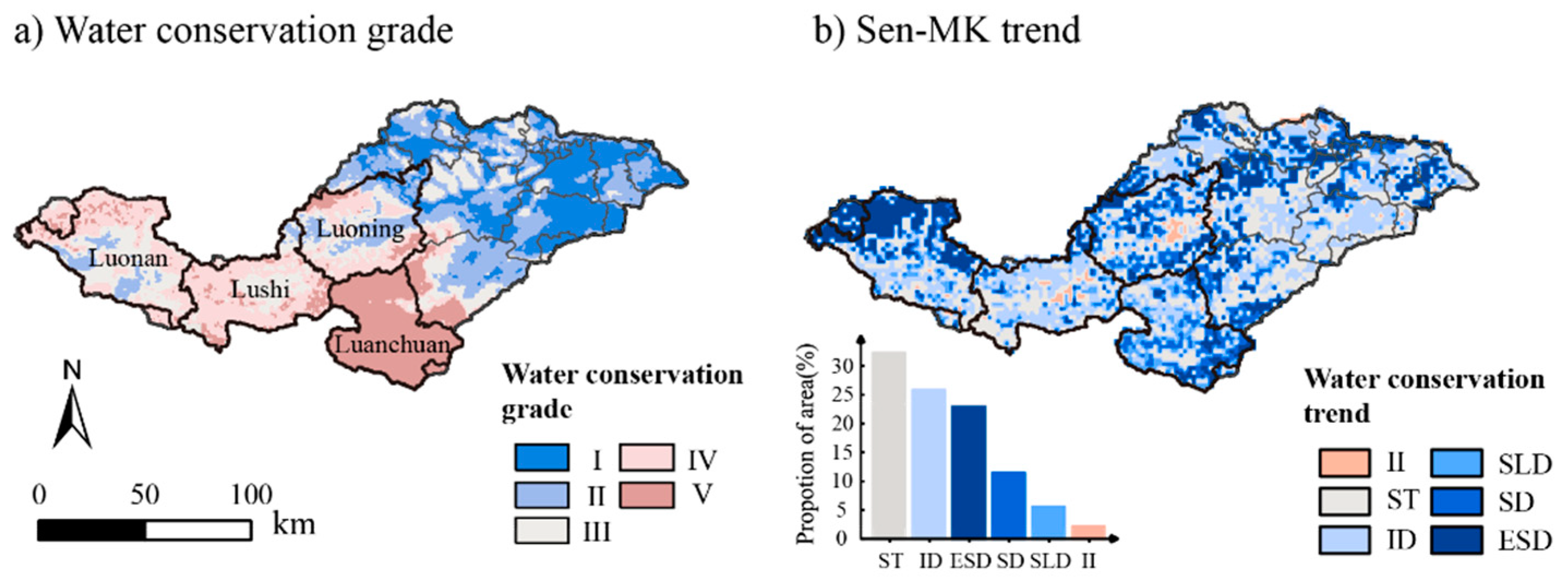
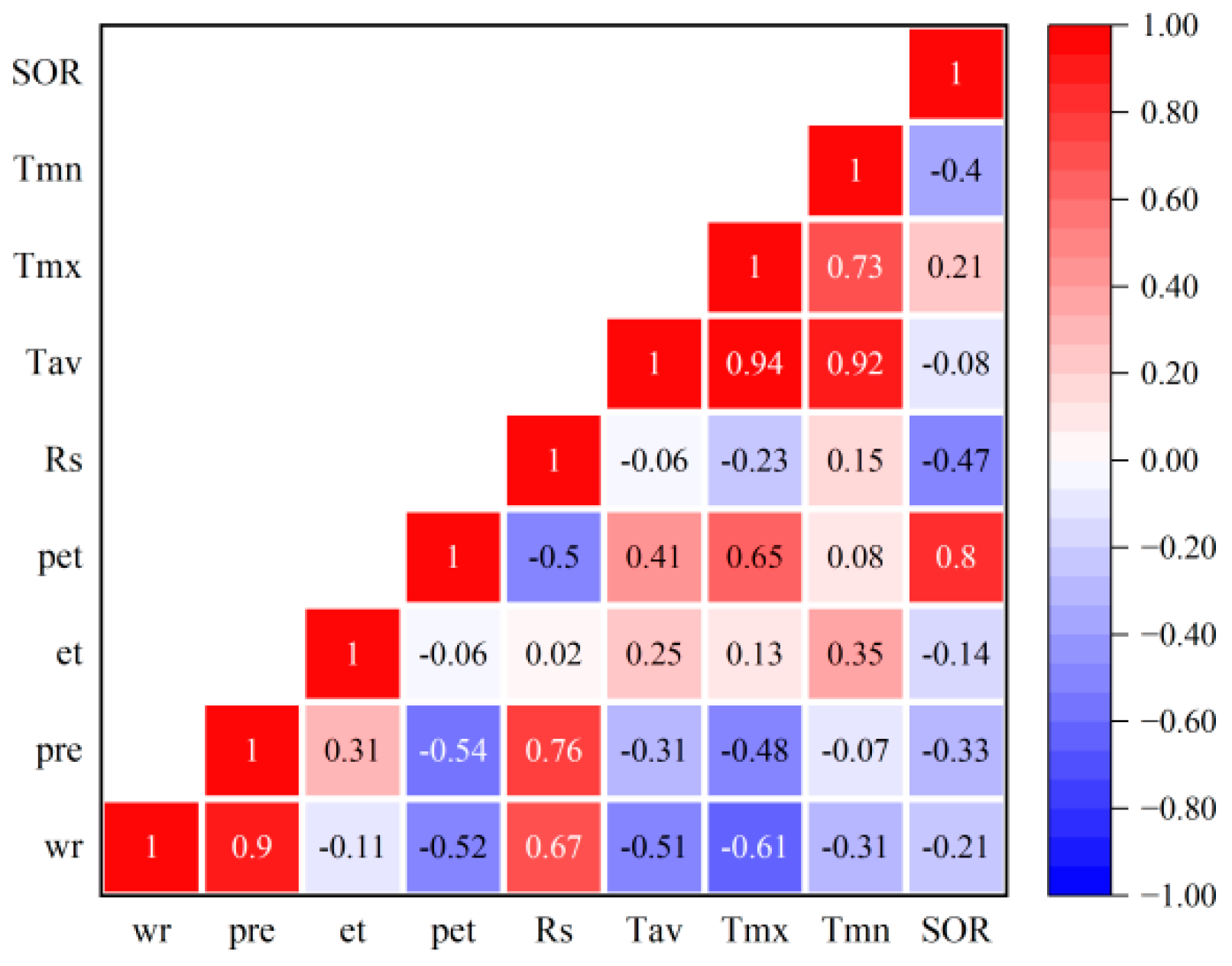
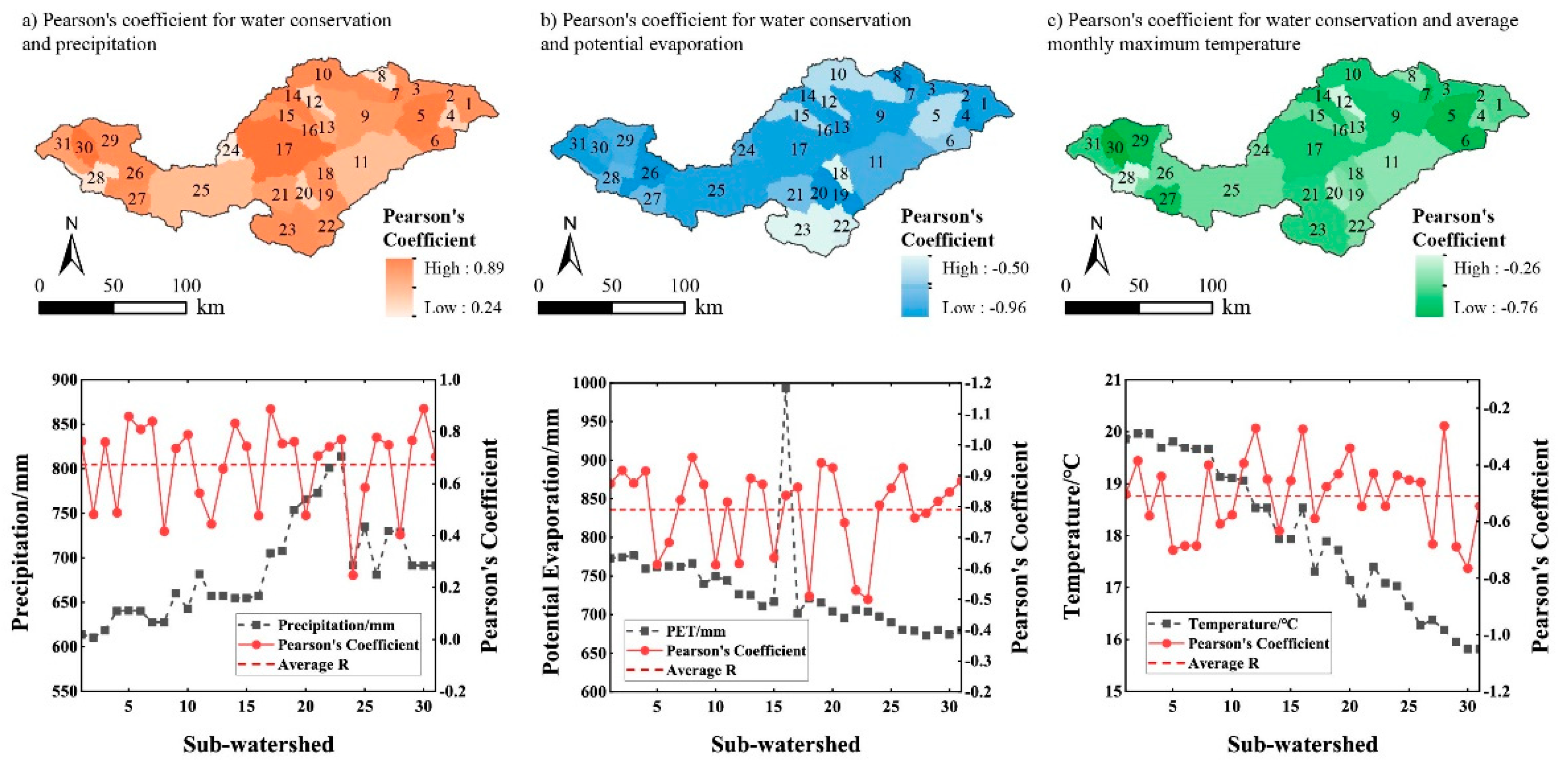

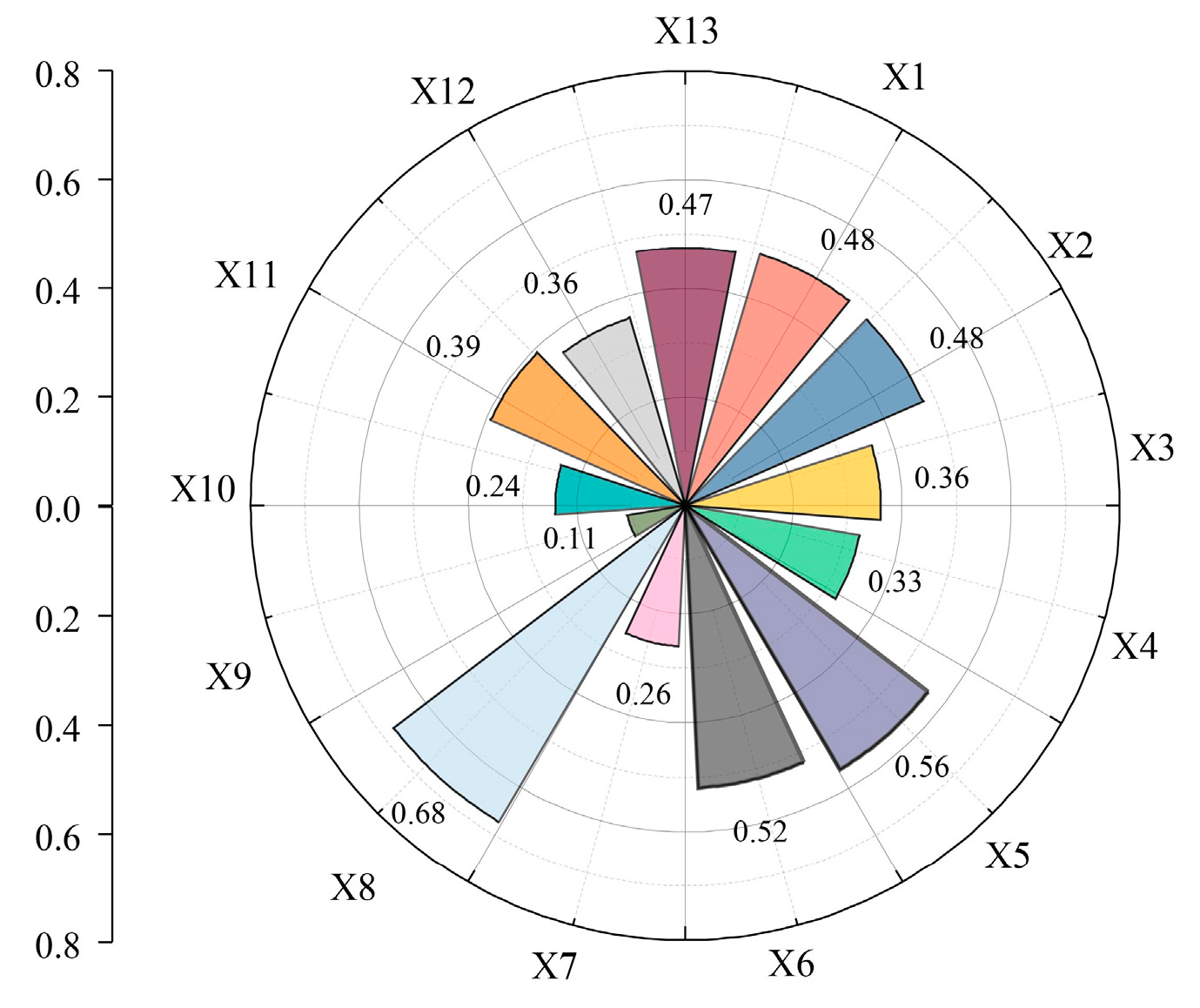
| Data | Data Source and Processing Method |
|---|---|
| Meteorological data | Including precipitation, temperature, wind speed, and sunshine hours, obtained from CN05 gridded observation dataset [24,25,26]. |
| Land use/cover | Obtained from National Tibetan Plateau Science Data Center (https://data.tpdc.ac.cn). |
| Soil data | Including soil saturated conductivity, available water content, soil texture, soil matric bulk density, and electrical conductivity, obtained from National Tibetan Plateau Science Data Center (https://data.tpdc.ac.cn). |
| Digital elevation model | Obtained from Geospatial Data Cloud: ASTER GDEM 30 M resolution digital elevation data (https://www.gscloud.cn). |
| Hydrological data | Monthly streamflow data obtained from Yellow River Basin Hydrological Yearbook. |
| Number | Parameter | Physical Definition | p-Value | t-Stat |
|---|---|---|---|---|
| 1 | CN2 | SCS runoff number | 0.0000 | −25.90 |
| 2 | ESCO | Soil evaporation compensation factor | 0.0000 | −22.94 |
| 3 | SOL_BD | Wet compacted weight of soil | 0.0000 | −9.80 |
| 4 | SOL_K | Saturated hydraulic conductivity | 0.0000 | −8.08 |
| 5 | SOL_AWC | Available water capacity of soil | 0.0000 | 7.40 |
| 6 | GW_DELAY | Delay time of groundwater | 0.0000 | 4.54 |
| 7 | ALPHA_BNK | Basic alpha flow factor | 0.0001 | −3.99 |
| 8 | CH_K2 | Main channel hydraulic conduction | 0.0696 | 1.82 |
| 9 | SLSUBBSN | Length of overland flow | 0.0760 | 1.78 |
| 10 | GW_REVAP | Coefficient of groundwater revap | 0.1280 | 1.52 |
| 11 | EPCO | Plant uptake factor | 0.1358 | 1.49 |
| 12 | REVAPMN | Water depth threshold in shallow aquifers for “revap” | 0.2457 | 1.16 |
| 13 | CH_N2 | Manning value for main channel | 0.2843 | 1.07 |
| 14 | GWQMN | Shallow aquifer thresholds required for regression flow generation | 0.3040 | −1.03 |
| 15 | ALPHA_BF | Baseline flow alpha factor | 0.3510 | −0.93 |
| 16 | HRU_SLP | Slope of HRU | 0.4018 | −0.84 |
| 17 | OV_N | Manning’s n value for overland flow | 0.7202 | −0.36 |
| 18 | SFTMP | Snowfall temperature | 0.8205 | 0.23 |
| Period | Time | NSE | R2 | P-Factor | R-Factor |
|---|---|---|---|---|---|
| 1 | Calibration (1966–1975) | 0.79 | 0.79 | 0.71 | 0.66 |
| Validation (1976–1985) | 0.82 | 0.88 | 0.48 | 0.44 | |
| 2 | Calibration (1986–1995) | 0.78 | 0.79 | 0.68 | 0.71 |
| Validation (1996–2000) | 0.77 | 0.87 | 0.55 | 0.68 | |
| 3 | Calibration (2001–2010) | 0.85 | 0.86 | 0.79 | 0.77 |
| Validation (2011–2018) | 0.72 | 0.80 | 0.70 | 1.08 |
Disclaimer/Publisher’s Note: The statements, opinions and data contained in all publications are solely those of the individual author(s) and contributor(s) and not of MDPI and/or the editor(s). MDPI and/or the editor(s) disclaim responsibility for any injury to people or property resulting from any ideas, methods, instructions or products referred to in the content. |
© 2024 by the authors. Licensee MDPI, Basel, Switzerland. This article is an open access article distributed under the terms and conditions of the Creative Commons Attribution (CC BY) license (https://creativecommons.org/licenses/by/4.0/).
Share and Cite
Jia, Y.; Jin, J.; Wang, Y.; Guo, X.; Du, E.; Wang, G. Evaluating the Spatiotemporal Distributions of Water Conservation in the Yiluo River Basin under a Changing Environment. Water 2024, 16, 2320. https://doi.org/10.3390/w16162320
Jia Y, Jin J, Wang Y, Guo X, Du E, Wang G. Evaluating the Spatiotemporal Distributions of Water Conservation in the Yiluo River Basin under a Changing Environment. Water. 2024; 16(16):2320. https://doi.org/10.3390/w16162320
Chicago/Turabian StyleJia, Yufan, Junliang Jin, Yueyang Wang, Xinyi Guo, Erhu Du, and Guoqing Wang. 2024. "Evaluating the Spatiotemporal Distributions of Water Conservation in the Yiluo River Basin under a Changing Environment" Water 16, no. 16: 2320. https://doi.org/10.3390/w16162320
APA StyleJia, Y., Jin, J., Wang, Y., Guo, X., Du, E., & Wang, G. (2024). Evaluating the Spatiotemporal Distributions of Water Conservation in the Yiluo River Basin under a Changing Environment. Water, 16(16), 2320. https://doi.org/10.3390/w16162320









